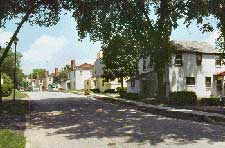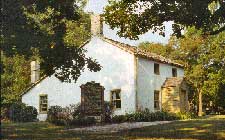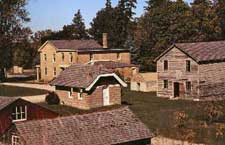MILWAUKEE COUNTY LANDMARKS
Greendale
Original Village of Greendale
Bounded by Loomis Road (east) and West Grange Avenue (north)
Landmark Designation: 1976
During the 1930s, “ Greenbelt ” communities were planned and built by the federal government outside three major metropolitan centers – Baltimore, Cincinnati, and Milwaukee. The projects demonstrated the value of urban planning, while providing employment opportunities and relieving the shortage of low income housing.
The Resettlement Administration of the U.S. Department of Agriculture purchased 3,400 acres of farmland and woods for the development of Greendale. In May 1938, the first housing units were occupied. There were 572 living units in 366 buildings, half of which were single family homes built of cinder block on poured concrete foundations. Most houses were built on cul-de-sacs which discouraged heavy traffic while necessary vehicles used three major thoroughfares. The community’s focal point was designed to be the Greendale Village Hall, built in a style reminiscent of Colonial Williamsburg.
The sale of the Greenbelt towns was authorized in 1949 and Greendale was purchased by the Milwaukee Community Development Corporation in 1952. Original tenants were given first option to purchase their Greendale homes.
Jeremiah Curtin House
South 84th Street and West Grange Avenue
Greendale
Landmark Designation: 1979
David Curtin, his wife Ellen, and infant son, Jeremiah, were among a group of Irish immigrants who settled in Greenfield in the late 1830s. After living in two log homes, Curtin, with the help of an Irish stone mason, built a stone house in 1846. The limestone structure resembles a traditional Irish cottage.
The Curtin family continued to occupy the house after David’s death in 1856 and Jeremiah’s departure for college in 1858. In 1866, the property was sold to the neighboring Trimborn family. The house was occupied until the 1920s. In the 1930s, the vacant structure became part of the federal government’s Greenbelt project. In 1952, federal government turned over the house to the Milwaukee County Historical Society. However, funds for its restoration were not available until the nation’s Bicentennial observance in 1976.
Curtin House, the first stone house in the old Town of Greenfield, is important historically as part of Milwaukee County’s early Irish settlement and also as the boyhood home of Jeremiah Curtin. Curtin became an accomplished linguist, author and world traveler. Aided by his facility for languages, Curtin wrote extensively on the language and folklore of primitive peoples all over the world.
This Curtin House is also listed on the National Register of Historic Places.
Trimborn Farm
Designation includes house, barn, bunkhouse, and lime kilns
8881 West Grange Avenue
Greendale
Landmark Designation: 1979
Werner Trimborn acquired this Greenfield farm in 1850 and it proved valuable not just for the richness of the soil, but for the vein of limestone which lay underground. The production of lime was an important industry in pioneer Wisconsin as it was used in construction, in making soap and paper, in the purification of water, and as a fertilizer.
Trimborn’s farm was soon producing 200 barrels of lime daily with the assistance of forty laborers and at least fifty horses. After Trimborn’s death in 1879, his sons August and Leonard continued the business until the development of Portland cement made lime production unprofitable. The fires in the kilns died out and in 1935 the Trimborn property became part of the federal government’s Greenbelt project.
Today the complex includes the Cream City brick farmhouse, one of the last stone barns in Wisconsin, a bunkhouse for the workers, root cellar, and a 75-foot kiln. The property was acquired in 1980 by the Milwaukee County Park Commission for development into a historic site in conjunction with the neighboring Jeremiah Curtin House.
The Milwaukee County Historical Society took over management of the property in January 2004 for the Parks Department, and uses it for educational purposes for school children as well as adults. Several events, showing what life was like in that period, take place year-round on the Trimborn Farm buildings and grounds.



